Modern Horizons has officially released, and we are primed to see the Modern landscape shift with an influx of cards entering the format. The set appears to provide support across various archetypes, with an emphasis on fringe and lower tier strategies. Coupled with War of the Spark’s release and the official implementation of the London mulligan next month, Modern will be going through an enormous transition. I don’t expect the format to settle for a couple of months.
After a week of Magic Online data, the big winners appear to be Bridgevine and Vizier Combo, due to new and now-legal Modern cards in Hogaark, Risen Necropolis and Eladamiri’s Call. As a result, there are premature claims calling the format is too degenerate and un-interactive. And that, of course, has led to calls for banning cards.
Despite these claims, I feel there’s an excellent solution: Karn, the Great Creator. Karn provides a wealth of options to answer the threats of the format efficiently, plus there is the Mycosynth Lattice combination. Although it may seem contradictory to suggest Karn, the Great Creator as an answer to other archetypes given its two-card combo, but the card does a lot of work. Artifacts have been common in Modern sideboards for years, and Karn extends their application in game one.
With all the options available for Karn, it’s difficult to determine how many sideboard slots to develote to the silver bullet package. This week, I go into how to optimize your Karn, the Great Creator sideboard for your local metagame, along with some best practices for your toolbox sideboard.
Building Your Sideboard
Since writing about Karn, the Great Creator last month, the card has exploded across the Modern metagame. Amulet Titan and Mono-Green Tron decks have made good use of Karn, but the most successful archetype may be Eldrazi Tron. That archetype has posted many recent successes, including two copies in Top 8 of the SCG Invitational last weekend.
Eldrazi Tron
Although the SCG Invitational was a multi-format constructed event, you can’t ignore the success Karn, the Great Creator put up in Modern. Even outside of Eldrazi Tron, a copy of Amulet Titan achieved Top 8 success at the Invitational incorporating the Karn package too. It’s straightforward to add Karn to pre-existing archetypes given the easy mana requirement.
Although it may seem excessive to run both Mycosynth Lattice and Liquimetal Coating in your sideboard, it’s sound logic. There are some instances where you don’t have enough mana to cast Mycosynth Lattice, and Liquimetal Coating provides a safety valve to turn off your opponents’ key threats. In addition, Liquimetal Coating is a great budget option if you can’t afford Mycosynth Lattice any time soon. It’s not essential to run both, but definitely desired.
Despite Karn offering plenty of versatility, I think we are witnessing players mortgage too much of their board to accommodate the silver bullet package when it’s not required. Anything between seven to nine cards in the toolbox is ideal, as this allows you to run answers outside of the artifact card type. You will want to bring in cards game two, which can be awkward because Karn prefers the artifact answers to remain in the sideboard, so finding the right balance can be difficult.
Sideboarding for Specific Matchups
I’ll be breaking down the answers by what is currently prevalent in Modern, and it will require some intuition from you to know what popular strategies are cropping up in your local metagame.
Dredge/Bridgevine
As I mentioned briefly earlier, Hogaak Bridgevine is dominating the current Modern metagame. That will continue until the hype dies down, or people find the right answers to the strategy. There is no doubt that Hogaak Bridgevine is explosive as it is powerful, but answers exist. Admittedly, casting Karn, the Great Creator may be too slow, and this is why it’s important to run additional hate cards. Leyline of the Void, Rest in Peace and Ravenous Trap are all swift answers to the graveyard which are efficient in mana cost.
Notwithstanding, if the game lasts long enough for you to cast Karn, the Great Creator, Tormod’s Crypt and Grafdigger’s Cage are excellent answers to Hogaak Bridgevine and graveyard archetypes. Tormod’s Crypt keeps the graveyard clean and Grafdigger’s Cage prevents Hogaak, Arisen Necropolis from re-entering the battlefield.
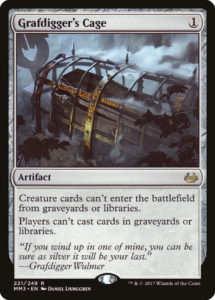
These cards apply to Dredge matchups as well. The two archetypes attack on a similar axis, though Hogaak Bridgevine is more explosive. It’s worth noting that Karn, the Great Creator can turn off an opponent’s Altar of Dementia or Shriekhorn, which can buy you additional time. Relic of Progenitus is another option to consider, though Tormod’s Crypt costs zero mana and can be cast and activated on turn four with Karn.
Izzet Phoenix
Despite falling out of favor lately, Izzet Phoenix remains powerful in Modern. That deck capitalizes on casting tons of cheap spells in a row, and artifacts such as Trinisphere can shut that plan down efficiently. If Trinisphere is out of your budget range, Defense Grid can be an excellent short-term alternative. Cards such as Damping Sphere are worth considering, depening on your deck’s strategy. If you are playing Tron, Damping Sphere isn’t ideal because it hurts you as much as the opponent, and there are answers which can tailor better to your needs. Other Karn decks may have more success with it.
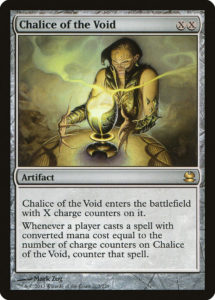
Chalice of the Void is another disruptive solution to cheap spells, and Ensnaring Bridge is a stubborn answer to a flipped Thing in the Ice and multiple Arclight Phoenixes. Typically, Chalice of the Void is a four-of in the maindeck in strategies such as Eldrazi Tron as it’s a card you want in your opening hand. But it’s a fine option to run a copy in the sideboard to ensure you always have one accessible. This is a trend we are beginning to see in Mono-Green and Eldrazi Tron, with a copy of Walking Ballista in the sideboard.
You can also wish for Tormod’s Crypt or Relic of Progenitus to prevent Arclight Phoenix from coming back. A lot of these answers are relevant against other strategies, and I would want to include these when taking the Karn toolbox to a high-level competitive metagame.
Humans/Bant Spirits
Humans is back on the rise thanks to its aggressive clock as well as disruptive answers in Meddling Mage and Kitesail Freebooter. Aether Vial strategies tend to lean on enters-the-battlefield effects.Torpor Orb switches off the majority of these strategies, but can present splash damage for your Thragtusks and Thought-Knot Seers. Despite this, it’s going to be a net positive for you.
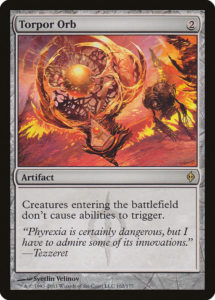
Sweepers are always good against these low-to-the-ground aggressive strategies, where Oblivion Stone can be effective if you want a safety valve alongside All is Dust. I’ve been trying out Skysovereign, Consul Flagship in my sideboard to decent success. Skysovereign picks off threats and blocks Mantis Rider all day long. In a different match-up, I’ve also used Karn’s plus ability to make my opponent’s Ensnaring Bridge a 3/3, which I destroyed with Skysovereign’s enters-the-battlefield ability.
Although Bant Spirits has fallen out of favor considerably, these artifacts are excellent against the archetype as well. Just be mindful of Spell Queller, which can exile Karn, the Great Creator and most of the artifacts you wish to cast. And remember that Karn switches off Aether Vial, which can restrict your opponents plays considerably. I would prioritize Ensnaring Bridge and Torpor Orb highly if your metagame is full of Humans, Spirits, or tribal archetypes.
Titanshift
Scapeshift strategies tend to perform well but fly below the radar. Titanshift has consistently made Top 8 of Modern Grand Prix over the last few months, and it looks to be well-positioned. We have a handful of answers to slow down Scapeshift strategies, with the key one being Witchbane Orb. The first ability is rarely relevant (unless your opponent is on Dimir Mill), but providing Hexproof is an excellent answer to prevent Valakut, the Molten Pinnacle damage. This can force the opponent to go for the Primeval Titan beatdown, which you can then shut down with Ensnaring Bridge.
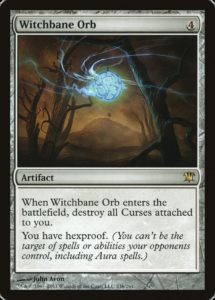
Depending on what variant of Scapeshift is prominent in your metagame, cards such as Sundering Titan could be excellent. Sundering Titan preys on greedy manabases, and the more obscure version of Scapeshift like Bring to Light are as greedy as manabases can get. Mindlock Orb is another obscure option, as Valakut strategies tutor through their library for lands, but it can punish you too.
Tron/Eldrazi Tron
Tron mirrors usually hinge on who can complete Tron or resolve Karn Liberated first. While this still may be the case, plenty of Tron matchups depend on resource denial and aggressively using Ghost Quarter to hinder your opponents’ gameplan. This is where Crucible of Worlds comes into play, which provides insurance by allowing you to replay your lands. I would have Crucible of Worlds in my wish board for sure. Field of Ruin and Ghost Quarter are still commonly played, and I want to carry out my game plan as intended.
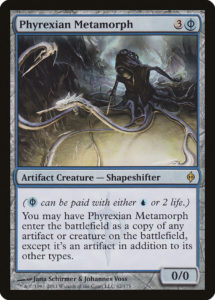
Ensnaring Bridge can prevent a top-decked Reality Smasher dealing lethal damage. On the flip side, I’m a fan of Phyrexian Metamorph in the mirror. Copying an opponent’s Ulamog, the Ceaseless Hunger or World Breaker isn’t a terrible line to take, and copying your own Reality Smasher can be game-ending too. If your local metagame is heavy in aggressive and creature-heavy strategies, Phyrexian Metamorph may be a nice addition to the wish board.
Burn
Burn isn’t as popular these days, but it remains a well-loved strategy in Modern. It has the potential to produce powerful early turns that put you on the back foot, but Wurmcoil Engine can negate that damage. If Wurmcoil sticks around for a turn or two, you are likely to win the game. Outside of this, Chalice of the Void counters cheap spells and Witchbane Orb can prevent you from ever being targeted with burn spells.
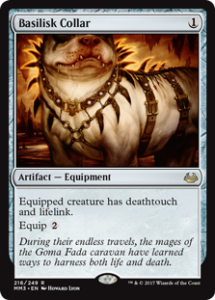
Prioritizing life-gain is essential against Burn, and Wurmcoil Engine will present the highest impact on the battlefield. You could wish for Phyrexian Metamorph to copy a Wurmcoil if you want extra life. Basilisk Collar is another nice option if you already have creatures on the field. If you don’t have access to either of these, Dragon’s Claw is a fine budget answer that offers splash damage against Izzet Phoenix and other red-based aggressive strategies.
Vizier Combo/Toolbox Creature Decks
Devoted Vizier strategies have been gaining traction due to new tutors like Finale of Devastation and Eldamiri’s Call. As a result, the strategy has a much more consistent gameplan that requires some preparation against. Grafdigger’s Cage is excellent at preventing creatures from entering the battlefield via Collected Company or Finale of Devastation, and offers an answer for Neoform strategies too. Witchbane Orb can prevent an infinite Walking Ballista from ever targeting you.
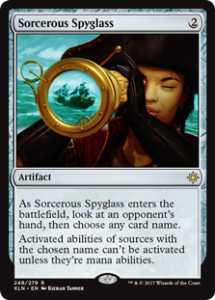
Pithing Needle or Sorcerous Spyglass aids the cause as you can name Devoted Druid to shut off its second ability. Choosing between Pithing Needle or Sorcerous Spyglass is dependant on whether you are running Chalice of the Void in your build. Chalice on one is more common than playing it on two, and you do gain the benefit of the extra ability by peeking at your opponent’s hand. If you are running Chalice of the Void in your build, then I’d recommend Sorcerous Spyglass. Otherwise, I’d recommend Pithing Needle.
Wrapping Up
As you can see, Karn, the Great Creator offers a wealth of options outside of using the Mycosynth Lattice or Liquimetal Coating combination. Despite the importance of including both of these cards in your toolbox, it’s also essential to note what is prominent in your local metagame. By having access to Karn, the Great Creator, you are essentially working with a sixty-five to seventy card deck.
Karn will only improve as new artifacts join the format. It’s important to remember that Karn, the Great Creator is powerful outside of the Mycosynth Lattice combination and will continue to see extensive play if Lattice get banned, for example. This new Karn is here to stay.
Emma is a writer and Modern enthusiast based in Suffolk, England. She has been involved in Magic since Khans of Tarkir’s release back in 2014, but won’t shy away from Cube and MTG Arena. Follow her on Twitter @emmmzyne to join in on the conversation!

